Our fourth blog in the series “Where to stay in Mallorca” is about Central Majorca.
Central Mallorca, along with the northwest of the island, is the most authentic. Central Mallorca is less visited by tourists than the northwest. But this region is particularly popular with cyclists and hikers. The centre of Mallorca is rural. Here you find the large agricultural area Pla de Mallorca. Flat plains, vineyards, almond trees and olive groves. Little traditional villages and fields with typical Mallorcan fincas (farms). It is the most important area for wine production. There is one larger town in the area: Inca. The heart of Mallorca is beautiful and peaceful. In Spring the almond blossom gives the landscape a fairy-tale look. There is a big advantage of staying in this area. All corners of Mallorca are not further away than about 1-hour drive. If you want to discover the real Mallorca, you have to spend some time in the central area of Mallorca.
Alaró
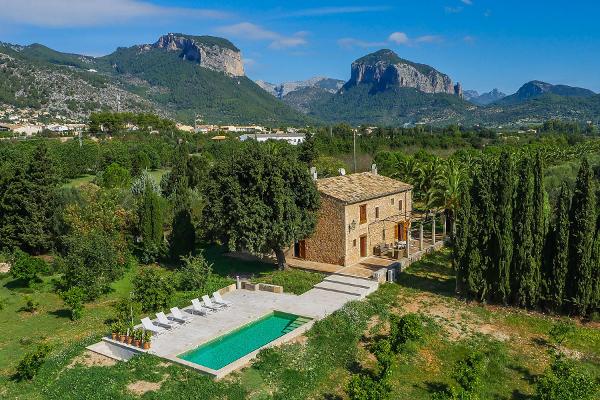
Let´s start our journey in the town of Alaro. The first thing you notice when you enter Alaro are the twin peaks. Two almost identical mountains. One is the Puig d´Alaro with the castle of Alaro. This is a peak of 822m. The other peak, s´Alcadena, is 815m high. There are many legends about the twin peaks. Legends about witches and kings.
The village of Alaro is small and cute. It has more than 5000 inhabitants. A mix of locals and expats that moved here. Tourism focusses on hikers and cyclists.
Talayot
In the surroundings of Alaro there are many Talayot sites. They refer to the time the first people started to settle here (123 AD). A Talayot is structure of piled up stones. Used as watchtowers and for ceremonies. Es Pico, Son Paulau and es Claper des Gegant are talayots dating from this period (iron age).
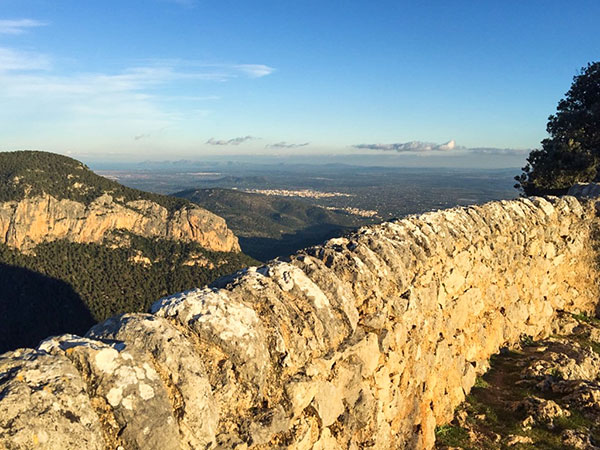
The Castle of Alaro
A visit to the Castle of Alaro is a must do. It is one of the three rock castles on the island. The known history of the castle goes back to the year 902. It was a castle built for military reasons. Many lost their blood here. From the centre of Alaro there is an excellent, straightforward walk to the remains of the castle. This hike is about 2 hours. At the top you have impressive views towards Palma. There is a “refugio” where hardcore hikers stay during the night. If you don´t fancy to do the whole route on foot you can park your car at Restaurante Es Verger. This place is famous for its lamb. From the terrace the views are great. And sometimes you get company from one of the sheep while eating. Make a reservation as it is very popular. From here the top is an hour by foot. It is also possible to reach the castle from neighbouring village Orient.
Alaro´s electricity
Alaro was the first town of the island with an urban electricity network connection. This was in the summer of 1901. The Alaro Electricity Company set up a power station, like to a plant in Barcelona. In 2000 the electricity tower of the plant got the status of Monument.
Shoe industry
Shoe making was the most important industry in Alaro. At the top, there were more than 30 factories giving jobs to over 2000 people. In the first World War some of the boots of the French army came from Alaro. Over the years all factories closed. But the factory of Tony Mora is still alive and definitely worth to visit. Now you still see some traces that refer to the importance of this industry. Placards on houses with the name of the shoe factory. Or a wooden shoe last to decorate a front door.
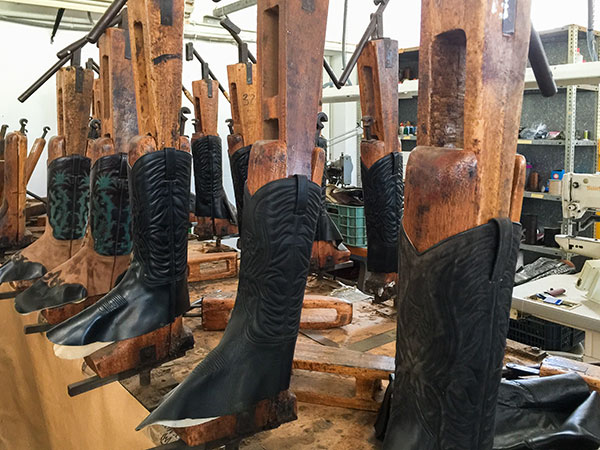
Tony Mora
Right before you enter Alaro you see the factory of Tony Mora Boots on the left. Boot makers for more than 100 years. In 1918 Tony Mora started its adventure of making boots by hand. In the 1960s the export to America begins. Boots production for cowboys is a fact. In the 1980s the brand becomes popular in Europe. As of 2000 famous designers dress their models with Tony Mora boots on the catwalk. Since 2010 each client can design its own boots. You choose leather, decoration, colour, stitches etc. Tony Mora is an icon when it comes to cowboy boots. Celebrities like Mick Jagger and Kate Moss order boots from Tony Mora. It is possible to visit the factory in Alaro. It is interesting to walk through the workshop. See the sewing machines, the wooden lasts, the heels and the various types of leather. In the morning it is most likely to see the factory in operation. There is also a shop.
The village
The heart of the village is the lively main square. Here you find the Sant Bartomeu Church, the town hall in baroque style and a variety of bars and restaurants. With good weather terraces are full of locals, cycling groups and other tourists. Stroll the cobbled streets with typical blond stone Mallorcan houses. Five minutes from the square you will see the old wash basinof Pontarro. Alaro has several shops but is not a shopping destination. There are some small art galleries.
Los Damunts is the oldest district of Alaro. In the 13th century this neighbourhood was the centre. A nice area for a relaxed walk. Watch the buildings and daily life. If you end at the little square of Cabrit I Bassa you can have a drink on the few terraces. Or have an excellent paella in the restaurant with the same name.
Every Saturday morning the weekly market takes place on the main square. A cozy market with fruit, flowers, vegs, clothing etc. On the same morning you can join an organ concert in the Church. Entrance is free.
Alaro has different restaurants like Sa Tafona, Traffic in Hotel Can Xim and Terra Mar & Foc. In the town itself you will find some small boutique hotels. Most of them in beautiful old buildings. Outside the town is 4-star hotel ´s Olivaret. A rural estate at the foot of the Tramuntana mountain range. And a popular wedding venue.
Events
For a small town there is a good calendar of events. Processions in town with Easter, Fiestas the San Roc and the process of the Giants. During the summer months there are a lot of music events. Theme fairs take place during the year. A typical traditional activity is “The Dance of the Cossiers”. This is one of the oldest dances of Mallorca. Over the years the choreography and costumes changed. In Alaro the cossiers dress up in red, pink and blue. All wearing a baroque hat. There are 6 dancers, a Dame and the Devil.
Hiking and cycling
Alaro is the perfect base for hikers and cyclists. There are many routes available. For hikers the most popular one is the route to the Castle.
Bodegas
Being so close to the best wine area of island, Alaro has some important bodegas.
Castell Miquel is a bodega on a slope in a green environment. The building looks like a castle. Castell Miquel is not a large-scale producer like some others. Less production, but higher quality. Visits of the bodega are possible. The other bodega in Alaro is “Vinyes d´Alaro”.
Orient
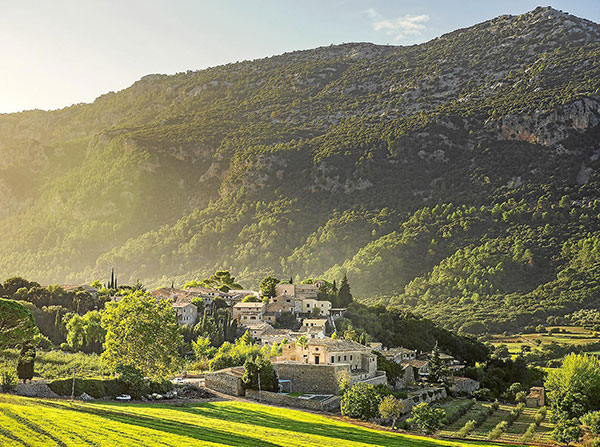
Orient is a remote hamlet at the foot of the Tramuntana mountains. About 30 people live here. It has narrow streets and pretty houses from the 15th and 16th century. A hub for cyclists and hikers. Many routes start from Hotel Son Palou. An excellent rural in a traditional stone building. Nice pool area with lovely views. The road from Alaro to Bunyola is the only road to reach Orient. But don´t worry, this is a very attractive drive with green fields, sheep, mountains and more.
The Orient region has some nice waterfalls. These arise after heavy rainfall in autumn and winter. A visit to the falls is worthwhile. The waterfall Es Salt des Freu is one of the best. Adventurers can also do canyoning.
Orient is home to top restaurant Mandala. Excellent food, welcoming and a nice setting. Avoid disappointments and reserve a table.
Consell
Consell is a small village close to Alaro. It attracts much less tourists than some of the neighbour towns. If you want to visit, you best walk around through the village and get a feel of village life. But don´t expect any interesting buildings or nice boutiques. Around the square is the best and most lively area.
The weekly farmers market is on Thursday morning. Like the shops in Consell, it is a market for the locals. Tourists better go to the big markets of Santa Maria on Sunday or Sineu on Wednesday.
Having said all this, there are two good reasons to stop in Consell. The first is the Fleamarket on Sunday morning. The second reason is a visit to Ribas Bodega.
Every Sunday morning hundreds of people visit the Fleamarket in the industrial polygon. It is the largest flea market on the island. There is a large variety of second-hand items are. If you cannot find here, you can find it nowhere!!
Bodega Ribas
This bodega is the oldest winery on the island. Since 1711 the Ribas family makes wine here. They have more than 40 hectares of vineyards. Among others with grape varieties like Prensal and Mantonegro. The bodega is open to public (after appointment). Located in a beautiful home from the 18th century. The original historic barrel cellar is still intact. Taste wine in their romantic backyard. Visit their website to see what type of visits are available. You can choose from a simple tasting of 1 hour up to a complete wine-paired menu.
Binissalem
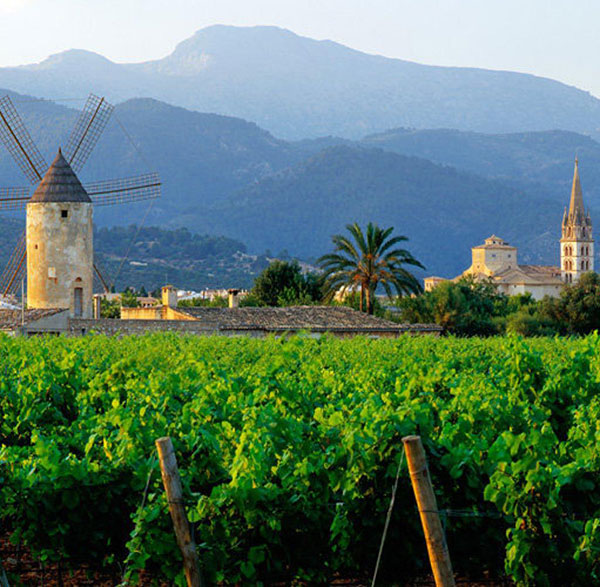
Binissalem is a pretty little village in the middle of the vineyards. Founded in 1300. If you say Binissalem, you say “wine”. This authentic town is the beating heart of the Mallorcan wine production. Apart from wine, Binissalem is famous for its stone. Walking through this rural town, you will see some historical buildings and houses. And some shops, bars and restaurants.
The village
A traditional Mallorcan town with flair. The scenery is pretty. Vineyards and always the Tramuntana mountain range as background. In many buildings you see the typical, beautiful stone of Binissalem. It gives the village her special charm. The Plaça de l’Església is the lively large square in the centre with some restaurants, shops and terraces. This is the place where locals and foreigners come together. Sit on a terrace and enjoy the daily life around you.
Close by, is the lovely church “Iglesia de Santa Maria Robines”. The church dates back from the 18th century and is in Baroque style.
Casa Llorenç Villalonga is a literature museum in a typical Mallorcan house. It is this house where writer Llorenç Villalongalived every summer. Since 1999 the museum exists under the name Fundació Casa Museu Llorenç Villalonga. The main purpose is to promote the life and work of important Mallorcan writers of the 20th century.
Shopping is the day-to-day shopping and some local souvenirs. The weekly market is on Friday morning. There is a good choice of restaurants. Have a meal in Es P´dal. Of course, with a glass of wine from the region. If you love to eat snails, you should go to Sa Caragolera. This snail farm is a few minutes by car from Binissalem.
There are no hotels in Binissalem itself. But there are some rural hotels nearby. A great place to stay is Es Cuatro Cantons. Housed in an impressive farmhouse from the 19th century. Luxury with a lot of character.
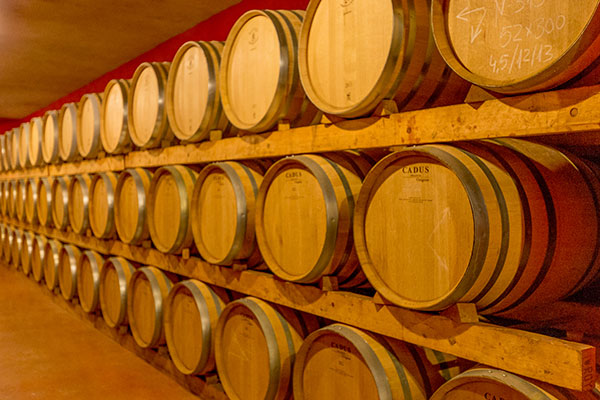
Wine, wine, wine
Since 121 BC wine grapes grow in this area. Wine production has always been very important. But in the 19th century the Phylloxera virus hit the area. The villagers started to plant almond trees. And the export of farm equipment to f.i. France became more important. At the end of that disastrous century the wine industry revived. In the beginning of the 1990s Binissalem got a Denominacion de Origen. It was the first area that received a DO.
The DO is a name used for wine or food that 100% originates from a region. It is a system to classify the product and guarantees a high quality. The DO Binissalem consists of Sencelles, Consell, Santa Maria, Binissalem and Santa Maria. The climate in this area is excellent for cultivating wine grapes. Likewise the natural circumstances. About 10 wineries are part of DO Binissalem. All family owned and not too big. They use native grape varieties for their high-quality wines.
Wine tourism gets very popular. The DO Binissalem came up with the so-called Wine Route. It guides the tourist through the villages, the vineyards and the wineries. If you want to visit the wineries, make sure you have an appointment.
Events
September is the month to harvest the grapes. In this month the “Festa des Vermar” takes place. This is a popular wine fair with grape crushing, a grape fight, traditional music and dance. Of course, with wine tasting.
Another yearly event is the Stone Craft Fair. It is a Fair that shows the traditional stone-working in the village. In the streets you will see stone cutting, sculptures and more. The stone of Binissalem is very famous. Some call it the Mallorcan marble. Often used in local architecture. There are 3 stone categories in Mallorca. The stone of Santanyi, Marès and the stone of Binissalem. The last one is a durable stone, in grey or beige. Because of its characteristics often used for fountains, stairs and columns.
Santa Maria del Cami
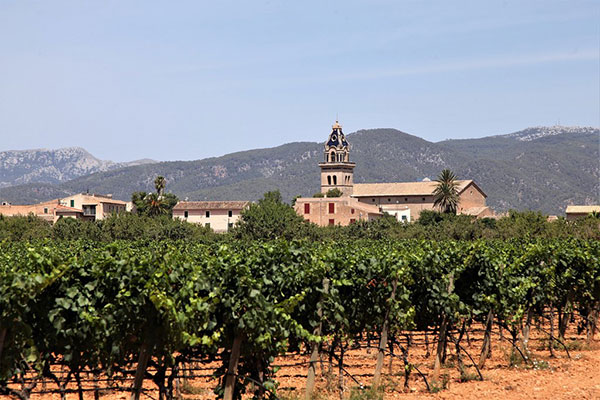
Another typical Mallorcan village. Famous for its huge market on Sunday mornings. The liveliest part is the main street crossing the village. Flanked by terraces, restaurants and shops. All cyclists visit Santa Maria. You will see them sitting in groups on one of the terraces. Santa Maria is a mix of locals and expats. It is an excellent wine area. It has some attractive buildings like the church that you can see from far. It not the prettiest of all villages in Central Mallorca. But it definitely has a good vibe and is worth to spend some time here.
You cannot miss the blue-tiled roof of the Parish Church. Dating from the 18th century and built in Baroque style. Close to the church is the town hall. Housed in an interesting building dating from the same century.
Shopping
Santa Maria del Cami is home to a few excellent shops. Living Dreams, Wesco and Barkonsult APS are must see stores.
Living Dreams is a fantastic concept store relating to in- and outdoor living. A store on 3 floors in a beautiful old house. Unique items are coming from all over the world. And they have their own production. A gorgeous garden is the display for the outdoor furniture. If the client wishes, it is possible to produce tailor-made. There is a café and a restaurant, Bistro 19, with delicious food.
Villa Wesco is in the same street as Living Dreams. This lifestyle store sells high quality furniture and exclusive decoration items. It is home to colourful kitchen accessories from the German brand Wesco. And they are specialist for high-end outdoor kitchens
When you walk from Living Dreams to Villa Wesco you pass Barkonsult APS. Another great shop. Wholesale of bar and gas supplies. They also offer bar tools and items used at the dining table. As a private person you can buy a few items.
Artesania Textil Bujosa is a family business producing fabrics since 1949. It is the oldest of the island. Now the third generation is in charge. In the workshop you will see the typical Mallorcan fabric, “telas de lenguas”. Lengua means tongue and refers to the flame patterns. Apart from this type of cloth they also produce many others. As the quality and service is outstanding, they received several awards.
Weekly market
Every Sunday morning one of the biggest markets takes place on the Plaça Nova. The market is busy. Locals and tourists stroll through the alleys to find a wide range of local products. Olives, meat, bread, fruits and vegetables. Furthermore, there are leather bags, plants and much more. Often there are life animals, like chickens and roosters. A special corner is for ecological products and even a traditional head massage. To visit the market is a great experience. There is ample parking place.
Restaurants
In Santa Maria you will find a good range of restaurants. We already mentioned the excellent food in Bistro 19. But there is more. In the main street there are various Spanish restaurants serving tapas. For a special night out, we recommend “Moli des Torrent”. Seasonal high-quality food served in a historical mill.
Wine
We recommend visiting the Bodega of Macia Batle. This winery exists since 1856. During the tour you will learn everything about the production process. At the end you can taste 4 different wines with some local products. The tours are available in many languages.
Sencelles + Costitx
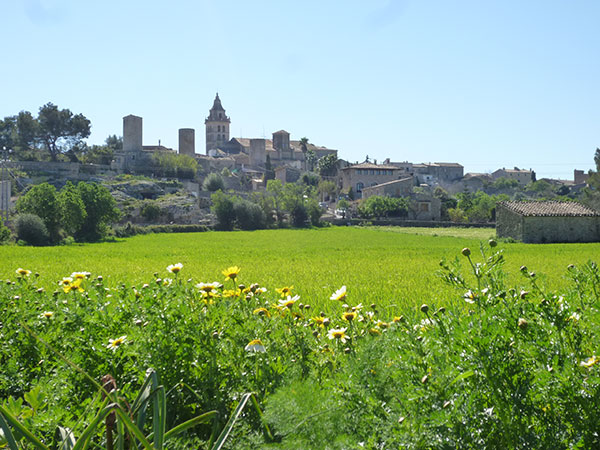
Sencelles is a cute village with 3000 plus inhabitants. The municipality consist of several villages. Biniali, Jornets, Son Arrosa, Ca´s Canar, Ruberts and Sencelles. Walking around you disover typical Mallorcan buildings. In the area are important archeological sites dating from the Talayot period. Agriculture is the main business. Wine production and fig cultivation are important pillars of the local economy.
The most significant building is the Parish Church of Sant Pere. After almost two years of hard work the construction of the church finished in 1864. Outside the church is pretty. But the “wow-factor” is inside. Next to the church is a statue of a famous inhabitant of Sencelles. Sister Francinaina Cirer Carbonell (1781-1855) had an important role in charity works. She also had renowned healing powers and miracles happened. One of them is the story about her very sick mother. She sent a little girl to the pharmacy in Binissalem. Unfortunately, it rained hard. Sister Francianaina gave the girl her hat to use it as an umbrella. The girl came back from her mission and despite the distance and the bad weather she was completely dry.
Sister Francinaina helped the poor and the sick. On 1st October 1989 Pope John Paul II beatified her.
In the surrounding areas of Sencelles are many typical Mallorcan windmills.
The small weekly market is on Wednesday. Fresh fruits and vegetables are the main products sold.
The archeological route will guide you to various important archeological sites. All in the area of Sencelles and Costitx. The route is 15 kms. Best is to cycle or walk.
The Agricultural Festival is a yearly important event in May. An agricultural event with sheep, wine and olive oil. Ideal to try some local products. During the festival there is a tapas route through the village.
Nearby Costitx is smaller and has about 1000 inhabitants. The main attraction in Costitx is the Astronomical Observatory. This planetarium inaugurated in 1991. Interested in astrology? Sign up for the guided tours!
On the 1st May Costitx converts in a flower village. With the Fiesta de las Flores locals decorate their houses and streets with flowers. The festival celebrates the beauty of the local flora.
Sineu
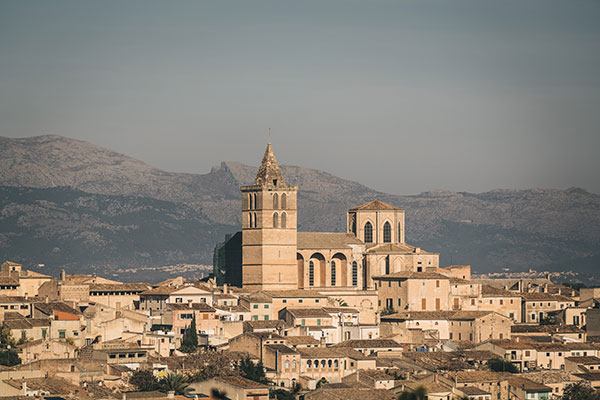
Sineu is the centre of Mallorca. A small, historical town with the best weekly market on the island. With a good variety of shops, bars and restaurants. And with some hotels. Less than 4000 inhabitants. The international community keeps growing. Sineu has a train station. The train is an easy connection with Palma.
If we look in the history books of Mallorca, we find out that Sineu was a very important town in the past. For a short period of time it was the capital of the island. King Jaume II built a palace. Many Kings of Mallorca lived here. Today it is a convent.
Highlight is the Parish Church of Santa Maria. An immense historical building that you see from far. Impressive from the outside. Beautiful from the inside. It dates back from the 13th century. Big parts got destroyed after a huge fire in 1505. The reconstruction and extension took several years. The church carries a local myth: “Pern del Mon”. The legend is that this “screw of the world” lays under the bell tower of the church. The Rector and the Mayor oil the screw every New Year’s Eve to avoid that the world falls down.
The first hospital in rural Mallorca comes from 1240. It is one of the oldest of Mallorca.
Every Wednesday the weekly market takes place in the streets of Sineu. A huge, traditional market. Visited by locals and many tourists. Stalls with local fresh products, clothing and souvenirs. One of the last livestock markets of the island. After visiting the market, it is a good idea to sit down on a terrace on the main square, Plaça des Fossar.
The weekly market is a big event. But the biggest is the Sineu Fair in May. This is the oldest market of Mallorca. Thousands of people head to Sineu to try the local products, see the animals and enjoy this big Fair.
Santa Eugenia

A lovely, quiet village set in a green environment. Steep streets, flour mills and very authentic. The name of the 1700 inhabitants is Taujans. Again, a typical Mallorcan village with narrow streets and houses with Mallorquina (shutters).
There are some historic buildings like the church and the house of Son Bosso. But the most important attraction of Santa Eugenia is the nature. It is a great base for hikers and cyclists.
The town hall developed some routes in the area.
An excellent walk leads over the Puig de Eugenia to the Lourdes Cave. And there are more trails.
The few shops in town offer day-to-day products. The market is on Saturday market and offers fresh, local produce. Santa Eugenia has some good restaurants and hotels. Restaurant Cellar de Sa Torre is an old wine cellar. It has the highest ceilings on the island. This ambiance gives an extra to the quality meals served. On the wine list is “Natiu Finca Sa Torre. A wine produced by themselves. Cellar de Sa Torre is part of the high-end Sa Torre Hotel.
The biggest event of Santa Eugenia is the Agricultural Fair in April. The Fair is about farming tools and farm animals. There is also a local cooking festival.
Bodega Vinya Taujana exists since 2001 and is family owned. They organize tours and wine-tastings with tapas.
Outside Santa Eugenia is a Zoo called “Natura Parc”. Home to the majority of the Mallorcan animal species. The park has a size of 30.000m². There are some picnic areas. And children can touch some animals in the “toca toca” area.
Inca
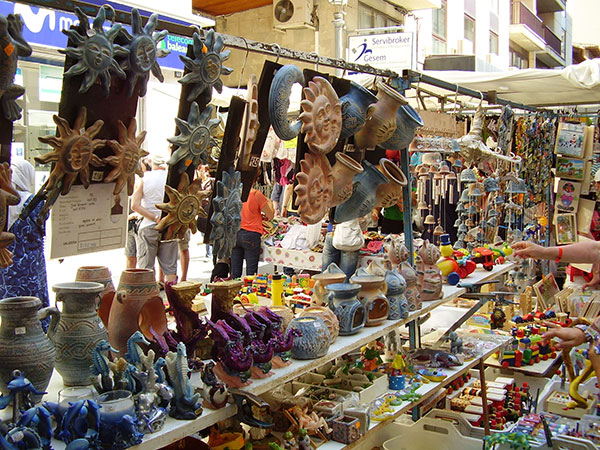
Inca is the only real town in Central Mallorca. It is the third largest town of the island. It has about 30.000 inhabitants. If you visit the centre of Mallorca for the first time you better skip Inca. There are more interesting and pretty places. That said, Inca does have some sights. There is a popular market. The range of shops is large. Some beautiful hikes start in Inca. And dining in a cellar restaurant is a must. Inca is famous for its leather industry.
In the heart of Inca is the Santa Maria la Mayor church. An impressive church in Baroque style which is also beautiful inside.
The Can Monroig House is a stunning building in the old Jewish neighbourhood of Inca. Currently used as a gallery with furniture, sculptures and art d. Can Monroig is also home to many cultural events.
Shopping
Inca has a very good shopping reputation. The large variety of shops in the old town are a must for a shopping-addict. Outside the centre there are some great leather outlets. Beautiful leather for a very good price. Inca is the capital of the leather industry in Mallorca. Before the wine pest hit Mallorca the people of Inca gave up on wine production. They started to work in the leather industry. In 1871 the first shoe-making factory of Mallorca opened. Now it is the famous brand Camper that still has its headquarters in Inca. As well as a huge outlet store.
You find more leather products on the weekly market on Thursday. A very big market in the streets of Inca that attracts hundreds of locals and tourists.
Dining in a Cellar
Inca is famous for its wine cellars. Many of them are now restaurants. It is very special to try a typical Mallorcan dish in such an environment. Unfortunately, Celler Can Amer closed its doors in the beginning of this year. But luckily there are more: Celler Sa Travessa, Celler Can Lau, Celler Ca´n Ripoll and Celler Ca´n Marron.
Events
In Autumn Inca hosts 4 successive Fairs ending with the largest Fair on the island “Dijous Bo”. The first Fair in the series is the “Feria de la Tierra”. This is about agriculture, plants and flowers and crafts. The second one is the “Feria de Ocio” with a lot of sportive activities. The “Feria del Arte” is a medieval market with a lot of shows, gastronomic events and market stalls.
Dijous Bo
The centrepiece of this series of Fairs is “Dijous Bo”. It means “good Thursday” and for the more than 200.000 visitors it is a very good day. It takes place on the third Thursday in November. For 2020 the date is set on 12th November. The history of this Fair starts in the 17th century. It was an economic Fair relating to the agricultural business of Mallorca. Now, Inca converts into a huge market. Everywhere there are activities. Like the contest of the Mallorcan Black Pig, cultural and music events and more. Some of these activities are on the Wednesday before. Many local products on offer. And if you want to buy a farm tool or an animal, this is the place to be. Surrender to everything Dijous Bo entails and enjoy a happy party / market day.
Inca´s Jazz Festival
July is Jazz-month in Inca. Every Sunday in July there are concerts, jazz workshops and jam sessions. It attracts local and international artists. Concerts take place in the Santa Domingo convent of Inca. The revenue of the Festival goes to a local charity.
Mushroom Festival
The Mushroom Festival takes place in neighbouring village Mancor de la Vall. It is the celebration of the harvest of that year. On the last day of November, the event starts with a procession of Mallorcan giants and the “nit de foc” (night of fire). Saturday and Sunday are the real days of the Fair. Apart from mushrooms you can find other local produce. Traditional music of the xerimier (the Mallorcan version of a bagpipe). And traditional dancing. Mushroom are and important product of the island. The best mushroom is the “Esclata-sang” or “Rovellon”. It grows in the Tramuntana mountain range. The “picornells” from Soller are smaller but tasteful. Try the local dish of picornells with sobrasada and honey.
Hikes
Some very interesting hikes start from Inca. The circular route to Puig de Santa Magdalena is an easy 10km hike. On top of the Puig you have great views over the island. Be aware that a big part of this route is on tarmic.
More challenging is the hike that leads to the Lluc Monastery. A beautiful sanctuary from the 13th century. This 24km route goes through the beautiful villages of Caimari and Selva.
Once a year, on a night in August, it is time for the Lluc a Peu event. This pilgrimage starts in Palma and is 42km long. Every year 10.000 people take part in this journey. Special buses pick up those who cannot reach the top.
Caimari
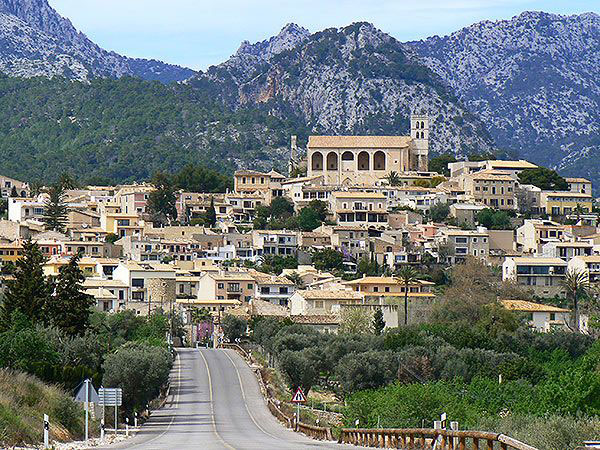
A sleepy, pretty village at the foot of the Tramuntana mountains. With typical Mallorcan houses and narrow streets. Famous for its olive oil production. An excellent base for hikers, cyclist and nature lovers. Home to one of the best restaurants on the island, which was recently visited by Michelle Obama.
Som 7
This is a co-operation between seven country and village hotel. The aim of which is to attract more people to visit the idyllic village. All seven were farms that were not able to survive the modern developments. The families decided to convert their homes into charming, romantic hotels.
Feria del Aceite
This Autumn Fair is about olive oil. You can learn about the olive oil production. And of course, taste some of the delicious oil produced. A great fair to spend some hours.
Restaurant Ca Na Toneta
A top restaurant in the heart of Caimari. Always serving dishes with ingredients that the season brings. Honest Mallorcan food. Inspired by dishes from the old days. Make sure you reserve a table as it always busy. In 2017 Michelle Obama had dinner here.
Selva
A picturesque, small town with about 4000 inhabitants. Very tranquil and traditional. Not affected by mass tourism yet. There are cyclists, nature lovers and hikers. The hiking route “Lluc a Peu” goes through Selva. The scenery is beautiful with the Tramuntana mountain range at the back.
Founded in 1232 and with the status of an Arab farm. Later it got the status of town. Since then history books describe stories of rebellion and bandits.
The most interesting sight in Selva is the majestic Church on the main square. The Esglesia de Sant Llorenç has a Gothic style. Set on the highest point in the area to be closer to God. The fire in 1855 damaged a large part of the church. All renovated in the years thereafter.
The “Valella Cross” dates back from early 1700s. A Baroque stone monument declared cultural heritage in the 1960s. The cross was the village border of Selva. And it was an important spot on the pilgrimage road to Mancor de la Vall.
In the centre there a few shops, bars and restaurants. As well as the workshop of local artist Joan Lacomba. Lacomba makes his artworks from rubbish and plastic.
The weekly local market is every Wednesday morning
June is the month for the annual Herb Fair. A two days Fair with on the second day the procession of the Myrtle plant. On the main square the plant is immediately distilled to make a “hierbas” licor.
Randa, Algaida, Montuïri and Porreres
On the southern edge of Central Mallorca, we find these four interesting villages.
Randa
Randa is a little village with a long pilgrimage history. It belongs to the municipality of Algaida. The Puig de Randa and its hermitages are the main attractions in this area. With 543m the Puig de Randa is the highest point in the area. It was Ramon Llull who started the first hermitage of Mallorca here. Living in isolation, Ramon Llull started around 1274 his missionary and intellectual work.
On top of the Puig de Randa are 3 different hermitages. The most important one is the Santuari de Cura. This is the one where Llull lived. Today, the winding road up to the summit attracts more cyclists than pilgrims. The hiking trail is 5km long and takes about an hour.
Algaida
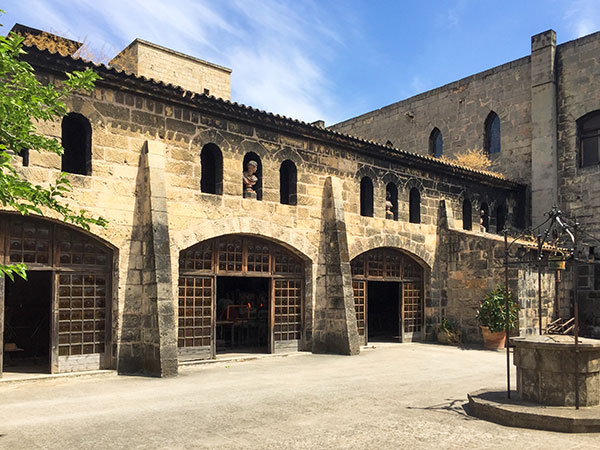
A small historical town in the Pla de Mallorca. There are about 5500 people living in this pretty old village. Typical Mallorcan with narrow winding streets and beautiful sandstone houses with green shutters. And of course, a main square where locals and tourists meet. There is a pretty church, Sant Pere i Sant Pau. A major point of interest are the windmills in the surroundings of the town. Most of them are from the 18th and 19th century. The big city of Manacor is less than a 30 minutes’ drive away. In the surroundings of Algaida are 6 hills. As well as some natural springs. The Puig de Randa is with 543m the highest mountain.
Algaida has an excellent reputation for local produce. The stalls on the Friday weekly market sell these fresh products. The local restaurants have an outstanding reputation.
A funny story is the one about the huge metal black bull on the road from Manacor to Palma. The bull is promotion material from a mainland sherry producer. Vandalists kept attacking the bull. To stop this, the bull got protected by the status of “national cultural icon”.
It is definitely worth it to visit to the Gordiola Glass Factory. You find Vidrios Gordiola in an imposing castle from the 18th century. It is the oldest glassblowing Factory on Mallorca. There is a workshop where glassshowmonstrate their skills. There is a museum and shop.
Montuïri
Picturesque, traditional and on top of a hill. That is Montuiri. Discover this charming village by foot. Surrounded by the typical Mallorcan windmills. Still now Montuiri´s main local produce are almonds and grain.
The buildings in the centre of Montuiri have different styles of architecture. Some date back to the Middle Ages. Other have clear Arab influences. In the past Montuiri was the place for money lenders. The big mansions in the village refer to that period.
What to see
In the centre you will see the monumental Sant Bartomeu Church. The religious paintings on the ceiling inside the church are very pretty.
Outside Montuiri is the etnologic museum “Els Calderers”. In the 17th century rural house is an exhibition of farming tools and interiors from the past. Also tasting of pork and wine.
Moli des Floret is a flour mill from the 18th century. It houses the museum of Son Fornes. Son Fornes is a pre-historic site, 2km from Montuiri.
On the summit of the Puig de Sant Miguel (661 m) is the Sanctuari de la Bona Pau. From this top you have the best views and you can visit the Sanctuari.
Market
The weekly market is on Monday morning. An ideal place to buy fresh local products.
Wine tasting
Close to Montuiri is the family-run bodega Jaume Mesquida de Mallorca. It is a biodynamic winery. There are tours and tasting of wine. But book in advance to avoid disappointment.
Events
Ever heard of a Partridge Fair? Montuiri has one. In the first weekend of December there is a partridge hunting competition. Further it is a Fair with animals, arts and tasting of local products.
The “La Fiesta de Sant Bartholomeo” is one of the bigger festivals on the island. It is the festival of traditions. The Montuiri cossiers dance on music coming from traditional instruments. Think of xeremies (bagpipes), tambourines and flabiols (flutes). The dancers have to beat the devil and save the lady of the ball. This event takes place in August.
Porreres
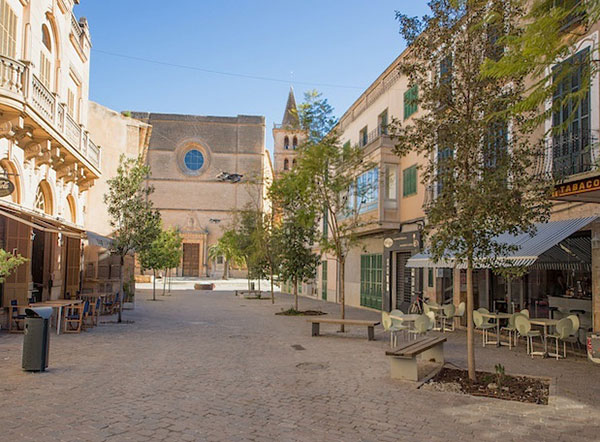
Porreres is a small town with a big church. More than 5000 inhabitants. Twenty per cent of which are expats. The name Porreres derives from Knight William of Porrer. Porrer and this troups chased away the Moors in the 14th century. Porreres is a tranquil, relaxed town. Not so many sights of interests but pretty enough to spend a couple of hours. It is another traditional village. With typical winding streets, old stone houses, a square and a church.
Nostra Senyora del Consolacion is a Gothic church in the centre. It is not the prettiest of all churches in this area, but it is always interesting to enter and see the interior.
The town hall in the main street (Avenida Bisbe Campins) is home to a modern art exposition. Even including works of Salvador Dali. In the same street you will see many bars and cafes.
Outside the village there are 36 windmills. And there is another Sanctury. The Santuari de Monti Zion is one of the “must see” sights of Porreres. This cloister lays above sea level and the views from the Santuari are fantastic.
Like all villages in Central Mallorca, Porreres has a rich agricultural tradition. Olives, almonds and apricots come from this area. By experience, we know that some delicious cheese (Prilac) comes from Porreres.
And with the village of Porreres we come to the end of this Blog. It has become a list of many villages. And this is exactly what Central Mallorca is. Beautiful villages that are too small to spend days. But that are too special to ignore them. In this area you can experience the other Mallorca. Our advice is to spend a few days cycling or walking in this region. Visit some pretty, authentic villages and enjoy the relaxed atmosphere. Of course, with a glass of beautiful wine from the region. Cheers!
Buy a property in Mallorca
The Northwest part of the island of Mallorca is our focus. If you are looking to buy a property in Mallorca, you should look at your handpicked properties for sale in Soller and the region of West Mallorca.
The region offers fantastic opportunities to buy a property ranging from apartments, country houses, villas.
You will see properties for sale with us in the region of Soller, Port de Soller, Fornalutx, Biniaraix and Deia. If you want to be alerted when a new secret property comes in the market, register here with us.